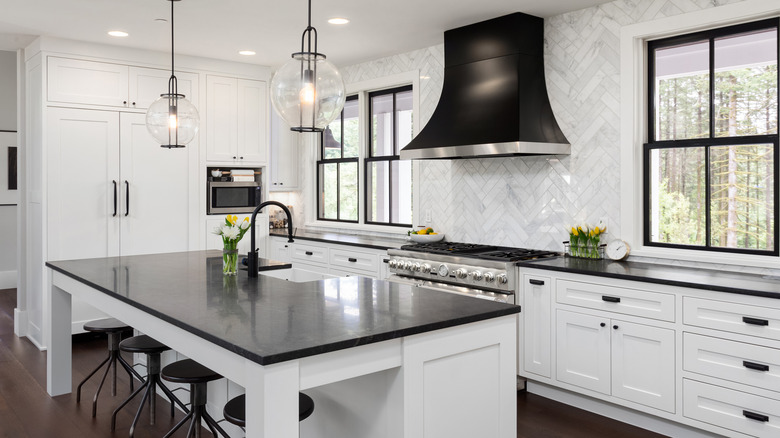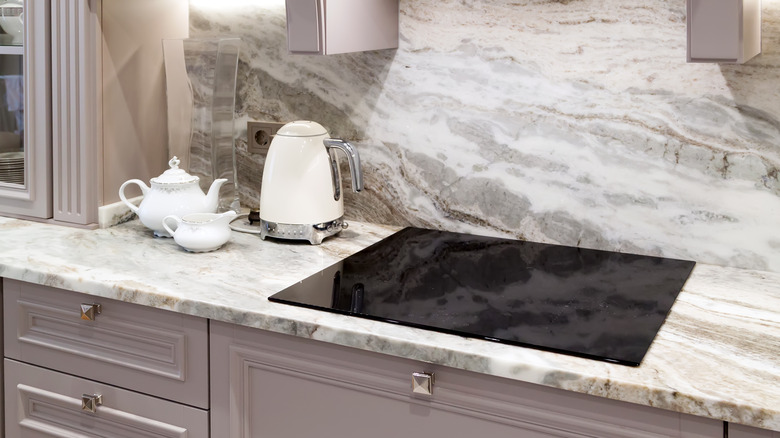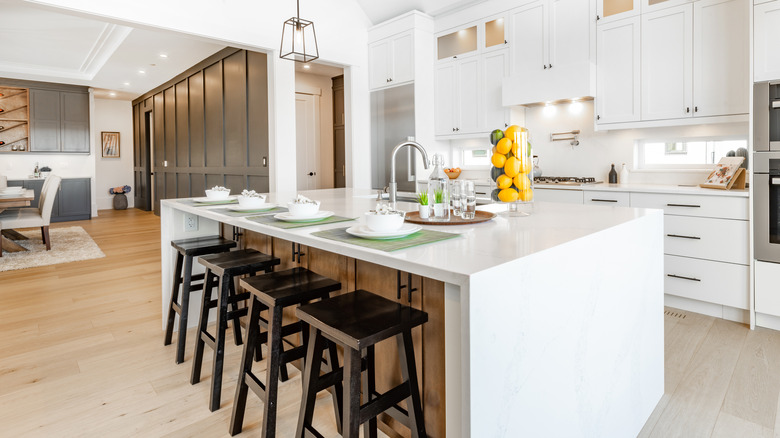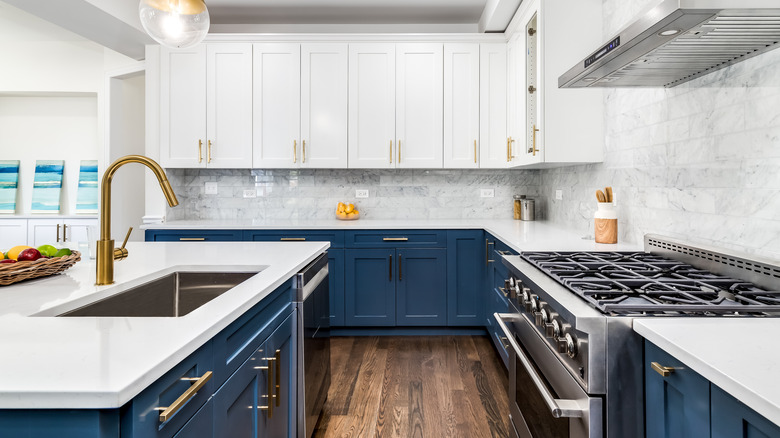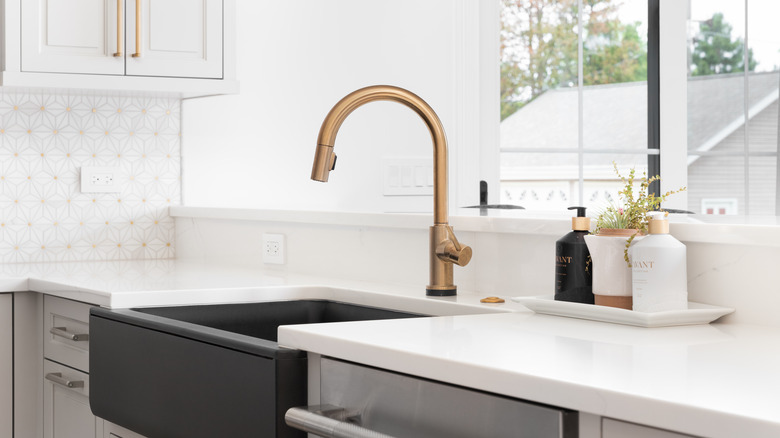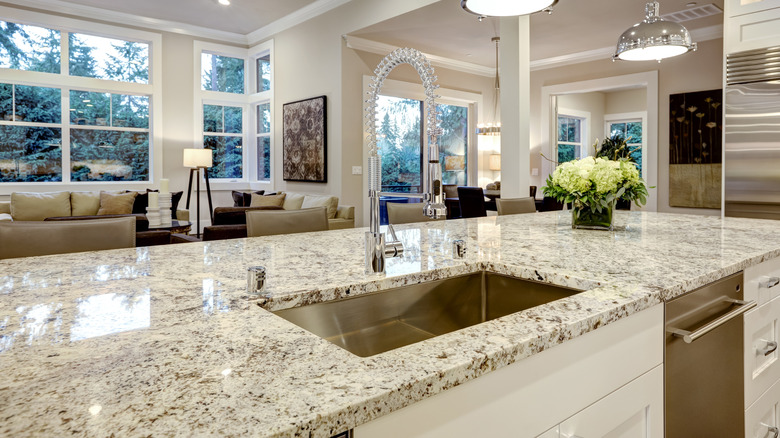How Much Are Granite Countertops?
Granite countertops are sought after by many homeowners for the beauty and durability they bring to a kitchen. Because an updated kitchen is a large contributor to home value and granite countertops are a factor in that raised price. So if you're looking to upgrade to granite countertops, how much can you expect to pay? According to Forbes, the average cost for granite countertops is about $3,300. Most homeowners can expect to pay between $2,000 and $4,500 for a slab of granite for their countertops. Per square foot, granite costs between $40 and $100. The price is often affected by the popularity or rarity of the granite. White granites like White Ice, River White, and Himalayan White are all popular options because of how the veining mimics marble. Black, gray, and tan are also popular choices because they are neutral shades that pair well with most home decor.
Slab size and quality will both play a role in the final cost of your countertops. Quality is determined by grades, with the lowest being ⅜-inch thick slabs. Mid-grade slabs are ¾ inch thick, while high-grade slabs are considered anything thicker. When considering the price of granite countertops, you must also factor in the labor of installing them. Expect to pay between $35 to $85 an hour for installation. Larger projects, of course, mean more installation. A small bathroom will be a lot cheaper than a large kitchen.
Factors for cost
No two granite slabs are ever the same, so prices can vary widely depending on the slab you choose to complete your renovation. Most slabs will fall between the average price of $2,000 to $4,500 per slab. But where it falls depends on factors such as quality, size, color, and rarity of the granite. The location of the property and your geographic location can also have an impact on the final price of the slab.
Location of Property
Where you live can affect the cost of your granite. Residents in cities with a higher cost of living often pay more. The cost of labor and materials needs to be higher in order to make a profit. In most locations, the average cost of the slab stays relatively the same. This is due to the price being decided on factors such as color, quality, and rarity that stay consistent from city to city. The cost of labor is what differs from location to location. With labor and material, the average cost for a granite countertop installation is about $2,100 in Atlanta, $2,800 in New York, and $3,400 in Los Angeles, according to Angi.
Quarry Location
Where the granite originates will also have an effect on the price. Brazil, China, India, and Italy produce most of the world's granite. Van Gogh Blue, one of the rarest granite colors, is quarried in Brazil. America and Canada also have granite queries. Location plays a role in price because the farther the slab has to travel, the more money it may cost. Shipping prices and importing fees are factored into the price of the slab.
Quality of the Slab
The quality grade of the granite will affect the price greatly. On average, you can expect to pay between $40 and $60 per square foot. At this price, you'll often find granite slabs on the lower and mid-grade. Lower-grade slabs have simple patterns and aren't as thick, about ⅜ of an inch. Gray, white, and green are the most common colors for low-grade granite. Mid-grade features more vibrant colors with more unique patterns and a variety of markings. High-grade granite is thicker than ¾ of an inch and has unique veining and uncommon colors. These higher-quality slabs can cost between $75 and $100 per square foot, according to Bob Vila.
Size of the Slab
The larger the slab of granite, the more the final cost will be. This is important to keep in mind as you prepare your project. Kitchens can often be pricey because of the size of the slab needed for counters. Multiple square feet of counters plus an island can increase the price. Bathrooms, on the other hand, can be more affordable. You often won't need as much granite for a bathroom vanity as you would an entire kitchen's worth of counters.
Granite Color
You'll find yourself paying more money for more sought-after colors of granite. More intricate and unique patterns, often found in rarer cuts, will also put your estimate in the higher range. White is one of the most popular colors for granite countertops, and high-quality white granite can be as much as $400 a square foot. Black has comparable popularity with high-quality versions at around $300 a square foot. Both are available at more affordable prices ranging from about $30 to $80 per square foot. Other colors include gray, gold, green, red, and blue. Blue granites tend to be the most expensive out of any color, with an average price of $70 to $100 per square foot.
Rarity of Granite
Because granite is made from natural stone, the rarity of the stones that make the countertop is going to contribute to the price. Rare granites are often only found in a few mines or quarries and in very small quantities. Blue granite is the scarcest of all colors, and that rarity comes with a hefty price tag. Blue granite varieties include Blue Pearl, River Blue, Blue Bahia, and Van Gogh Blue. Despite being a popular option, some black granites can be incredibly rare to find. Similarly, red and gold granites are rare and can increase the price per square foot.
Additional costs
You have options of finishing your granite countertops that may add to the final price. For example, the finished texture is an additional cost per square foot. An upgraded edge treatment will also increase the final price.
Granite Textures
All granite countertops will have a glossy finish, and these come at no additional cost. However, if you want to upgrade to a texture, you'll have to pay a little extra. Honed granite countertops have a matte finish. It will cost you an additional $10 to $20 per square foot. These countertops will need regular sealing every 2 to 3 months to maintain their appearance. Sealing is a project you can take on yourself, and a bottle of granite sealant ranges from $20 to $27. Leathered is the other upgraded granite texture where small ridges and pits are added to the surface of the granite. Only dark granites can be leathered because light granites don't have the strength to withstand the process. To leather a countertop, expect an additional $15 to $25 per square foot, says Bob Vila.
Edge Treatments
Granite edge treatments can also make homeowners incur an additional cost. Square edges are standard for granite countertops, but you can also have beveled, mitered, and bullnose edges. Premium edges include ogee, waterfall, cove, quirk, chiseled, and DuPont. The standard square edge won't cost you anything extra. But the other edges will cost you, on average, between $5 and $20 per linear square foot, says Remodeling Calculator. Custom corners cost between $50 and $140. Ogee and waterfall edges are the most expensive edge treatments, falling on the higher end of the spectrum. In contrast, half bullnose edges and single beveled edges are more affordable. Unique edges are cut into granite and require a lot of skill and the right materials. You'll have to ensure that your granite installer can provide the edge treatment of your choice.
Types of granite
Granite types are categorized by color, with each color category having specific variations styles. The color variations are due to the mineral makeup of the granite. According to the University of California, Berkley, granite is made of quartz, potassium feldspar, sodium feldspar, as well as common minerals like mica and hornblende. The most popular granite colors are white and black, but neutrals are also favored by homeowners.
White Granite
White granite contains white quartz, white feldspar, and dark granites that create the veining and speckles throughout the slab. Some white granites are loved for the way they mimic marble. White granite countertops can fit well in both modern and traditional homes. Popular white granite variations include Alaska White, Colonial White, Moon White, White Ice, and Salinas White.
Black Granite
Bold and modern, black granite is a popular option for contemporary kitchen designs. Pyroxene and plagioclase make up most black granites. Black granite often has white, blue, or yellow flecks in the slabs. Black Galaxy, Absolute Black, Ubatuba, Agatha Black, and Black Beauty are some of the most common variations.
Gray Granite
Contemporary, elegant, and warm gray granite often captures the best characteristics of each color. Gray granite will often have specks or grains of black, silver, and gold. Steel Gray, New Caledonia, Amparo, Arctic Grey, Azul Noche, and Barre Gray are popular varieties of gray granite.
Brown and Tan Granite
Brown and tan granites are ideal for homeowners who want warm neutrals or an earthy feel. These granites often have dark brown or black, red, or golden flecks throughout the slab. Baltic Brown, Antique Brown, Typhoon Bordeaux, and Bianco Antico are gorgeous brown and tan granite variations.
Blue Granite
Blue granite is unique and, as stated before, the rarest of granite colors. Blue granites can have veining in different blue shades, as well as black, white, and gray. Van Gogh, Blue Pearl, Sapphire Blue, Dynamic Blue, and Volga Blue are all popular variations of this rare granite.
Red Granite
Made predominantly of potassium feldspar, red granite is a stunning and unique slab for your home. Red granite can have specks and veining of gray, white, and black. New Imperial Red, Peachy Red, Lakha Red, and Ruby Red Granite all have a bold color in their slabs.
Why you need new granite countertops
Kitchens are high-traffic areas in your home, so it has to be in good condition in order to help you work efficiently. Aging, damaged, or outdated counters might be a reason to upgrade. If your current countertops aren't up to par, it may be time to get new granite countertops. Increasing your home value is another reason you should consider granite countertops.
Aging or Damaged Counters
Of course, if your current counters have signs of aging or damage such as cracks or erosions, you may want to consider a counter upgrade. This doesn't mean surface-level scratches but rather deep cracks that affect the look and integrity of your counters. Access your counters for stains, burns, and discoloration as well to help you decide if you need new counters.
Outdated Counters
Your counters might simply look old and, therefore, you're looking for something more updated. If you have tile or laminate counters, you may want to use granite counters to make your kitchen or bathroom look more contemporary.
Increased Home Value
If you're looking for renovation products that will increase your home value, focusing on the kitchen is a great idea. According to Home Guides, kitchen remodels can add 80% to 100% of the renovation cost to the home value. And new counters are a great feature to add to a new kitchen.
Benefits of granite
Homeowners have many options for their bathroom or kitchen countertops. But granite is one of the better choices. It's durable, resistant to scratches, stains, water, and heat, and is low maintenance, according to Apartment Therapy.
Durable
Because of its natural makeup, granite is an incredibly durable material. Falling at a six on the Moh's hardness scale, granite is harder than marble, which often makes it a better option for busy families or homeowners who love to get the most out of their kitchen. For those looking to make a long-term investment in their kitchen, granite countertops are a great option.
Granite Resistance
Granite's durability makes it resistant to scratches, stains, heat, and water. For the kitchen where all of these potential hazards are present, a material that can stand up to daily use is beneficial.
Low Maintenance
Once you properly seal granite, you won't have to do much to maintain the look and integrity of your counters. Depending on the type of granite counters you have, you may have to seal every few months to once a year. During this time, you don't need to use any special products for countertop maintenance.
